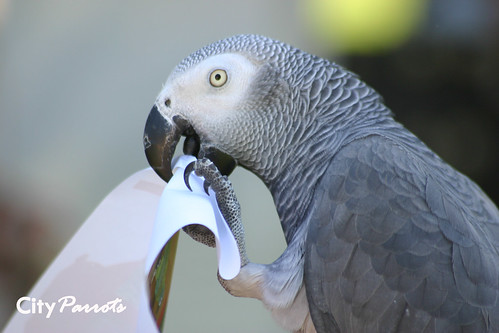Alex the parrot died in 2007, after learning more words than any bird before him. He changed the way people think about animal intelligence. But his education wouldn't have been possible without an unsung research assistant who pretended to be a parrot.
Alex, an African grey parrot, lived only a little over thirty years, but devoted almost all of them to science. His owner and fellow collaborator, Dr. Irene Pepperberg, asked a pet store employee pick a random parrot out for her. When she brought him back to the lab, she started trying to teach him language - not the mindless response that some animals are trained to give on a predetermined signal, but actual language that would allow people to understand his cognitive processes.
Alex could describe differences in the shape, size, material, and color of objects. He was also able to combine words he knew to make up new names for objects he'd never seen before. Scientists are still debating how much he actually understood of what he was saying. But how do you teach a bird to talk to begin with?
Humans learn language, for the most part, by watching other humans talk. We learn most words by hearing someone else say them and then puzzling out the meaning by context. Parrots, on the other hand, have been listening to humans talk for a long time without joining in the conversation. Humans are examples for other humans. A parrot has to be an example for another parrot. And when a talking parrot isn't on hand, a human will have to do.
Alex was trained using the Model-Rival method. Two people would be in a room with him. Pepperberg acted as the trainer, while her unfortunate assistant had to be Alex's fellow parrot. The trainer would talk to the assistant as she would to Alex, and give the person tests. For example, she would hold up a square and ask 'what shape' or 'what color'. When the assistant got the answer right, they would be praised, and petted, and given attention, and allowed to play with the shape. The rivals were encouraged to play with the shape in the same way the parrot would.
Alex would watch his fellow parrot, and get jealous. The other one was getting all the attention. So when it came to his turn, he would try to give 'correct' answers as well. The assistant researcher's job was to instill a sense of sibling rivalry in a parrot. What's more, they weren't always allowed to come out on top. They were not only Alex's rival, but the model that he could use to understand his training. Sometimes the assistant had to take a dive, giving garbled or incorrect answers. Then they would be punished - the trainer would hide the object from them - and try their best to look like a pining parrot. Alex learned from contemplating his rival's failure.
This method of training went on for decades, during which Alex became on of most famous birds in the world. He was in newspapers and magazines, giving people a better understanding of what an animal could understand, or at least be trained to do. Meanwhile, successive researchers - probably young ones - had to spend their days squawking and identifying, sometimes wrongly, how many corners a square had. When Alex died in 2007, many people around the world were saddened, and a lot of potential research was lost.
It's possible one person smiled a little, though.
